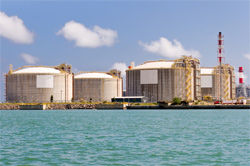Energy: the region more than ever depends on oil
Tuesday, August 28, 2012

Renewable energy sources have become more important in recent years, but still account for less than 15% percent of all the power generated in the region.
As far as natural gas is concerned, Guatemala last week announced that bids are likely to be invited soon for a 200-megawatt natural gas-fired power plant at Puerto Barrios on the country’s Atlantic coast.
The fuel would be imported in the form of liquid natural gas, known as LNG. When it reaches port, LNG is converted back to gas, and then sent by pipeline to power plants.
While gas combustion produces carbon dioxide, emissions are a third lower than those produced by burning oil. In addition, gas costs less than half as much as oil, for the same output of energy.
Nevertheless, the cost of building specialized port facilities, along with distribution systems, has so far been a deterrent for the region, which currently does not have a single power plant, which burns natural gas.
Worse, Central America in recent years has failed to maintain electric power production from hydroelectric sources, which in 2008 represented only 41% of total energy output in the region, compared to 66% in 1990, according to a report by the Institute of the Americas.
The result of these factors has been an increase in Central America’s dependence on imported oil, which went from 30% of total output to nearly half, in the same period.
"The region is therefore increasingly exposed to oil market volatility as the preponderance of thermoelectric generation depends on imported fuel oil and diesel as feedstock," say the report’s authors. Jeremy Martin and Juan Carlos Posadas.
Centralamericalink.com recently raised the point about the lack of natural gas in the region, noting that projects to bring natural gas to the isthmus - in El Salvador, Panama and Costa Rica – are still remote.
